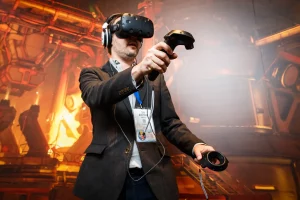Introduction
Augmented Reality (AR) has revolutionized the gaming industry, merging the digital and physical worlds to create immersive and interactive experiences. Unlike Virtual Reality (VR), which creates an entirely simulated environment, AR overlays digital content onto the real world, enhancing the user’s perception and interaction with their surroundings. This article explores the role of Augmented Reality in modern gaming, examining its impact, technological advancements, and future potential.
The Evolution of Augmented Reality Gaming

The concept of AR dates back several decades, but it wasn’t until the advent of smartphones and advanced computer vision technologies that AR gaming became feasible for the mass market. Early experiments in AR gaming were limited by hardware capabilities and lacked the sophistication seen in today’s applications. However, the release of powerful smartphones with built-in cameras, GPS, and accelerometers paved the way for more advanced AR experiences.
Key Milestones in AR Gaming

- Ingress (2012): Developed by Niantic, Ingress was one of the first successful AR games. Players interacted with real-world locations to capture virtual portals, blending physical exploration with digital gameplay.
- Pokémon GO (2016): Also developed by Niantic, Pokémon GO became a global phenomenon, bringing AR gaming into mainstream consciousness. Players used their smartphones to catch virtual Pokémon in real-world locations, fostering social interaction and physical activity.
- Minecraft Earth (2019): Leveraging the popularity of the Minecraft franchise, Minecraft Earth allowed players to build and explore virtual structures in the real world, further demonstrating the potential of AR in gaming.
Technological Advancements Driving AR Gaming

Several technological advancements have been crucial in the development and proliferation of AR gaming:
- Smartphone Capabilities: Modern smartphones are equipped with high-resolution cameras, powerful processors, and advanced sensors, enabling sophisticated AR experiences.
- Computer Vision and Machine Learning: These technologies allow AR systems to recognize and interpret real-world objects and environments, creating more realistic and interactive experiences.
- Cloud Computing: Cloud-based platforms enable complex AR applications by offloading processing tasks to powerful servers, reducing the computational burden on individual devices.
- 5G Connectivity: The rollout of 5G networks promises to enhance AR gaming by providing faster data transfer speeds and lower latency, facilitating real-time interactions and seamless experiences.
Impact of Augmented Reality on Gaming

AR has had a profound impact on various aspects of gaming, including gameplay, social interaction, and industry trends:
- Enhanced Game play: AR introduces new gameplay mechanics that leverage the real world, such as location-based challenges, object recognition, and spatial interactions. This creates a more immersive and engaging experience for players.
- Social Interaction: AR games often encourage social interaction by requiring players to collaborate or compete in real-world locations. This fosters community building and enhances the social aspect of gaming.
- Physical Activity: Unlike traditional video games, which are typically sedentary, AR games often require physical movement. This can promote a healthier lifestyle by encouraging players to explore their surroundings and engage in physical activity.
- Market Expansion: AR gaming has attracted a diverse audience, including casual gamers and non-gamers. This has expanded the market and created new opportunities for developers and businesses.
Challenges and Limitations

Despite its potential, AR gaming faces several challenges and limitations:
- Hardware Constraints: While smartphones are capable of supporting AR, dedicated AR hardware, such as smart glasses, is still in its early stages and not widely adopted.
- Privacy Concerns: AR games often require access to location data and camera feeds, raising privacy concerns among users.
- Battery Life: AR applications can be resource-intensive, leading to significant battery drain on mobile devices.
- Content Creation: Developing high-quality AR content is complex and requires specialized skills, limiting the availability of diverse and engaging AR experiences.
Future Potential of AR Gaming

The future of AR gaming holds immense potential, driven by ongoing technological advancements and growing consumer interest:
- Dedicated AR Devices: The development of dedicated AR devices, such as smart glasses, could provide more immersive and comfortable experiences, overcoming some of the limitations of smartphone-based AR.
- Integration with Other Technologies: Combining AR with other emerging technologies, such as artificial intelligence and the Internet of Things, could create even more sophisticated and interactive gaming experiences.
- Expanded Applications: Beyond entertainment, AR gaming concepts could be applied to education, training, and other fields, providing interactive and engaging learning experiences.
- Community and Collaboration: As AR gaming continues to grow, it is likely to foster even greater community engagement and collaboration, both within the gaming community and beyond.
Conclusion
Augmented Reality has significantly transformed modern gaming, offering new and exciting ways to interact with digital content in the real world. While there are challenges to overcome, the potential of AR gaming is vast, promising continued innovation and growth in the years to come. As technology advances and consumer interest grows, AR gaming is poised to become an integral part of the gaming landscape, shaping the future of interactive entertainment.




